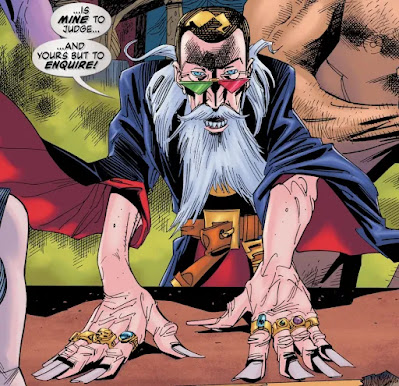Although my title references only the third part of the Moore/O'Neill CENTURY trilogy-- one of the last few offerings in the LEAGUE OF EXTRAORDINARY GENTLEMEN property-- I'm actually going to discuss all three parts, albeit briefly for Parts One and Two.
The title "Century" references the time-span of the three books, in which the three central characters attempt to head off a magical apocalypse. All three had appeared in earlier LOEG comics, with Mina Murray (of DRACULA fame) and Allan Quatermain having been charter League members, while Orlando, an amalgam of the medieval Roland and the immortal Virginia Woolf character, appeared slightly later. For most of the story Mina and Allan have become as immortal as Orlando, but their longevity doesn't seem to be of that much help. They spend most of their time chasing vague clues around London and getting railed at by their Blazing World boss Prospero, while Moore and O'Neill devote copious space to side-plots.
Part 1, dated "1910," is the least interesting of the chapters, largely because of Moore's peculiar conceit of subordinating his pop-fiction characters-- some semi-original, like the daughter of Captain Nemo-- to a long and pointless homage to Bertolt Brecht's THREEPENNY OPERA. The overbearing didacticism of Moore's script reduces this segment to the status of a null-myth, though Moore and O'Neill work in a ton of "occult investigator" types to set up the main menace. The most consequential homage is Oliver Haddo, who in Somerset Maugham's 1908 book THE MAGICIAN, creates supernatural entities called homunculi. Moore melds this Maugham concept with a "moonchild", a concept from real occultist Aleister Crowley and with the Antichrist of the Bible.
Part 2, dated 1969, takes place after both BLACK DOSSIER and a 1964 text-story I chose to bypass. Mina, Allan and Orlando return to London to pick up the trail of Haddo once more, but again there are a bunch of side-plots about gangsters and drug-addled musicians that don't come to much. In contrast to the three immortals, Haddo has managed to survive by continually transferring his consciousness into younger bodies. Mina foils Haddo's plan to transfer his mind into the body of a rich rock-star, but he still manages to take refuge in someone else's form, while Mina accidentally gets packed off to an insane asylum. Her disappearance estranges Allan and Orlando and they break up, with no intervention whatever from their mystic master. Moore and O'Neill don't succeed in emulating any aspect of the 1960s but the emphasis on psychedelia, though without getting into the reasons psychedelia was significant to the culture. Still, there's enough good psychological interaction between the principals that I'd term this a "near-myth."
With CENTURY #3, dated 2009, Moore and O'Neill finally get down to brass tacks. Prospero conveniently waits until the Antichrist Apocalypse is almost nigh to belabor Orlando for having lapsed in his duty. During that time, immortal Mina has remained in an asylum for forty years, and the bereft Allan has become hooked on drugs again. But thanks to Prospero's tardy bitching, Orlando decides to call upon British intelligence to find Mina. This plotline works because it follows logically from a subplot from BLACK DOSSIER, as Orlando encounters what is essentially a doppelganger for TV's Emma Peel. (In fact, all of the female characters from the two AVENGERS serials make appearances in CENTURY #3.)
Thanks to MI-6's information, Orlando finds and liberates Mina Murray. Unable to elicit further help from Allan the addict, the two heroines try to track down the Antichrist, who was born over twenty years ago and cultivated in what sounds like the other-world of Harry Potter-- all under the manipulation of the continually reincarnated Oliver Haddo. Finally Orlando and Mina confront the monstrous Moonchild, seeking to delay the demented creature until Prospero can send help, and Allan comes to their aid at the eleventh hour, only to meet his doom. The Moonchild, by the way, has some brilliant lines: seeing the two mortals challenging him, he complains, "I thought you'd at least be Jesus or an angel or somebody."
Though the Moonchild/Antichrist isn't a pop-fiction character, Moore sagely chooses just such an icon to vanquish the abomination: a never-named female who is in essence a cosmic version of Mary Poppins. (She destroys the Moonchild by reducing him to a chalk outline.) Orlando and Mina are left to mourn Allan, though their ally "Not-Emma-Peel" helps them return the adventurer's body to his adopted land of Africa. I assume that this denouement is an indirect tribute to the second Quatermain book by Rider Haggard, in which the hero dies (despite getting about six "prequel novels" afterward). Oddly, the LEAGUE OF EXTRAORDINARY GENTLEMEN film contrived a similar death for Quatermain, but I think it axiomatic that Moore, who has expressed antipathy for all of the film adaptations of his work, probably did not mean to homage this movie.
Of the four or five remaining LEAGUE works, I've read one and found it below par. I may force myself to read the rest in due time, but I'd almost like to imagine that the series ended with "Let It Come Down," despite all the damned Brecht references.







No comments:
Post a Comment